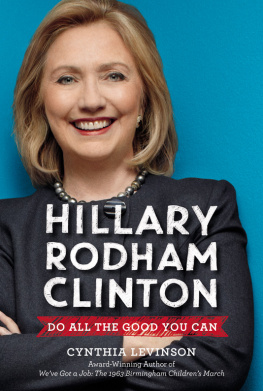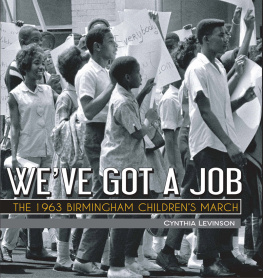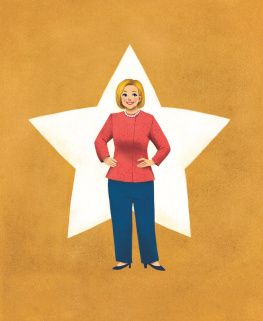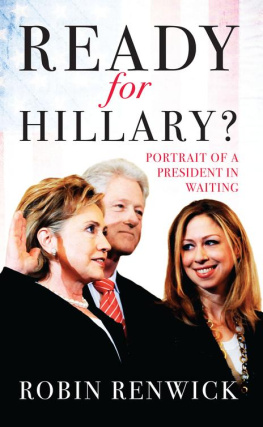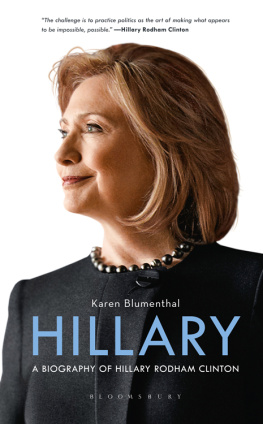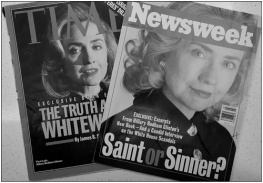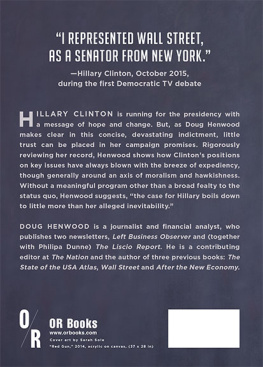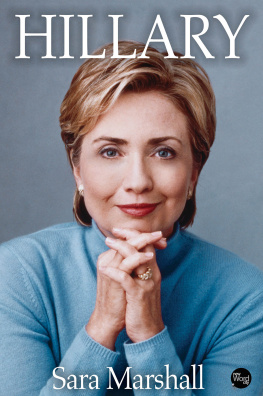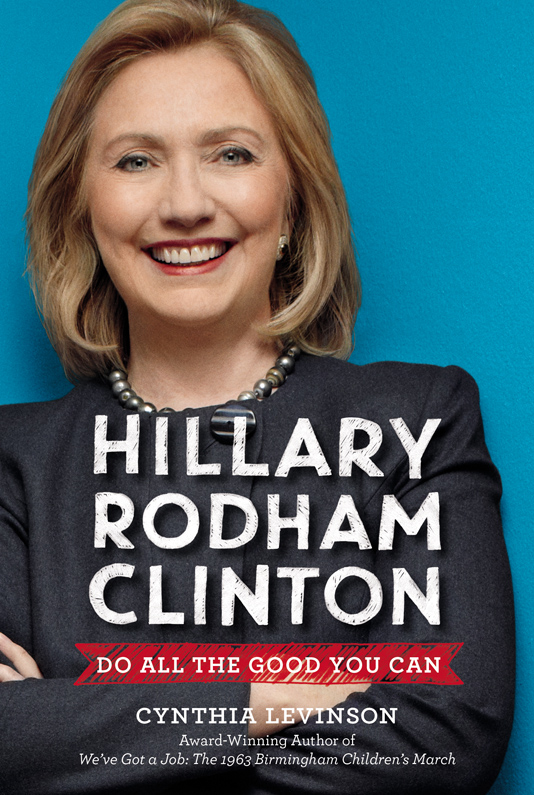To the many accomplished women in Davis Hall,
196467
CONTENTS
Guide
Star student.
Spokesperson for her generation.
Advocate for children, women, and families.
Corporate lawyer.
First Lady of Arkansas.
First Lady of the United States.
Health-care reformer.
US senator.
Secretary of state.
Two-time presidential candidate.
President of the United States?
These achievementsand even moreseem impossible for one person to accomplish in sixty-eight years. But Hillary Rodham Clinton has managed all of them. Is she some kind of superwoman?
Yes. And no.
She started life like lots of kids, made wise decisions and wretched ones, glowed with success and suffered humiliating setbacks. Like lunging for the next ring that dangles from playground crossbars and then the next and the next, Hillary has kept reaching.
A NOTE ON NAMES
Like a rock star, Hillary is a one-name phenomenon. Her staff respectfully calls her the First Lady or the Senator or Madam Secretary, depending on when they worked for her. In this book, I refer to her as Hillary because thats how she identifies herself. (On the telephone, she sometimes says, Hi, its Hillary!) Also, since her supporters declare that theyre Ready for Hillary, thats how the public knows her.
On the other hand, even friends call her husband Mr. President. But because this is Hillarys story and she calls him Bill, so do I.
My Immediate World Seemed Safe and Stable
When Hillary Diane Rodham was growing up, girls in Park Ridge, Illinois, did not wear jeans or shorts or T-shirts or sandals to school. They didnt wear pants, either, even on frigid days when icy winds swept across Lake Michigan and swirled through Chicagos northwestern suburbs. Instead, girls wore dresses or skirts, buttoned-up blouses, and, on their feet, black-and-white saddle oxfords or patent-leather Mary Janes with white socks neatly folded over. This was the proper look at Eugene Field Elementary School in the 1950s. And Hillary fit right in.
There was one way, though, that she stood out. No one else wore glasses like hers. They were as dense as the heavy bottom of a soda bottle and boldly rimmed in red frames, which emphasized her thick eyebrows. Other kids stared; her severely nearsighted eyes looked blurry through those lenses. So, Hillary sometimes took them off and let her friend Betsy Johnson lead her around school like a guide dog. Betsy had to whisper the names of people they passed in the hallway so Hillary could say hi.
There was another way that Hillary and her two younger brothers, Hughie and Tony, fit in. Like the other children at school, they were white and Christian. As far as she could tell, no Jewish, Asian, Hispanic, or black people lived in Park Ridge, and they would have been discouraged if they tried to move in. Hardly any schools or neighborhoods in the entire country were racially integrated.
They were, however, bustling with children. Born on October 26, 1947, Hillary was part of a baby booma dramatic increase in the number of children born during the late 1940s as American soldiers returned home following the end of World War II. The square block on which the Rodhams lived boasted forty-seven youngsters!
Hillary could dash out the door of their spacious, elm-shaded brick home and round up a flock of kids for pickup basketball, football, or softball. In winter, they played ice hockey on a rink created by a neighbor who flooded his backyard with his garden hose.
Every summer, the Rodhams spent two weeks at a rustic lakefront cabin that Hillarys father and grandfather had built in Pennsylvanias Pocono Mountains. With no hot water indoors, they bathed in Lake Winola, where they also swam and fished. Hillarys father even taught her and her brothers to shoot, lining up tin cans for target practice.
Today, we might call Hillary an all-around athlete. Back then, hardly any girls played sports, and she was known as a tomboy. She learned from sports, she said, You win one day, you lose the next day, you dont take it personally. You get up every day, and you go on.
Hillary began to learn this lesson when she was barely four years old, shortly after the Rodhams moved from a one-bedroom apartment near downtown Chicago to Park Ridge. She ran into the house, wailing that a girl named Suzy, who lived across the street with her brothers, had shoved her.
Theres no room in this house for cowards, her mother proclaimed. Youre going to have to stand up to her. The next time she hits you, I want you to hit her back.
Hillary didnt wait to get hit. She crossed the street, punched Suzyto her brothers astonishmentand reported to her mother, I can play with the boys now!
Mostly, though, Hillary kept the peace and obeyed grown-ups. She sat enthralled when her mother read and reread Dr. Seuss. While her brothers looked forward to the familys annual outing to Kiddieland for roller-coaster rides, she preferred excursions to Chicagos Field Museum, where she studied baby mummies.
She brought home almost all As on her report card; earned about as many Brownie and Girl Scout merit badges as could fit on her sash; cocaptained her schools safety patrol; and organized backyard carnivals and a mock Olympics, from which the athletes collected a paper bag of money that they donated to United Way.
Hillary also prayed and went to Sunday school, Bible school, youth group, and altar guild at First United Methodist Church. Her mother taught at Sunday school. We talked with God, walked with God, ate, studied, and argued with God, Hillary said. Each night, we knelt by our beds to pray. God sent sunbeams, she believed, directly to her.
Sometimes, though, Hillary learned traditional lessons the wrong way. In third grade, she hit a boy with a ruler because he had dinged her with a spitball. She thought the Golden Rule meant Do unto others exactly what they did to youinstead of Treat other people the way you would like to be treated.
Family lore had it that, in the eighteenth century, John Wesley himself, the founder of the faith, had converted Hillarys fathers great-great-grandparents in southern Wales. Wesley charged his followers with a straightforward guideline: Do all the good you can, by all the means you can, in all the ways you can, in all the places you can, at all the times you can, to all the people you can, as long as ever you can.
Hillary took this rule to heart and repeated it to herself, especially when she faced hard decisions. Those are words Ive tried to live by, she later said. Yet figuring out what was the good thing to do and the best way to do it would challenge her throughout her life.
For middle-class children like Hillary, the 1950s were a calm, orderly time. The Rodhams sat down to dinner every night at six oclock. Hillary especially looked forward to her mothers mac and cheese or meat loaf with dill pickles. After dinner, her mother helped her with English and history homework. Her father, whom she called Pop-Pop, oversaw math. The next morning, hed wake her up bellowing a favorite song, Aint We Got Fun?
My immediate world seemed safe and stable, Hillary recalled.
In fact, however, her home life was filled with strife. Both of Hillarys parents had suffered tough childhoods. Each tried to prepare and protect her in different ways.
Sometimes Hed Get Carried Away
The son of a poor immigrant and a local girl, her father, Hugh, attended college in Pennsylvania; however, he graduated in 1935, during the Great Depression, when jobs and money were scarce. Hugh worked in coal mines and for a company that manufactured lace. Anxious to do better, he rode freight cars, jumping on and off like a hobo, until he reached Chicago. There, he found a job selling curtains, and eventually started his own two-man company. Working fourteen hours a day, he designed, printed, measured, sewed, delivered, and hung curtains for hotels and banks.

